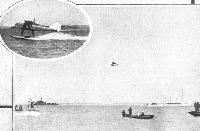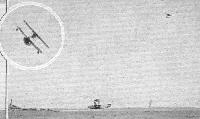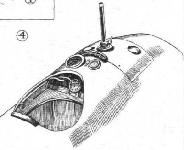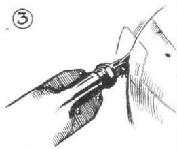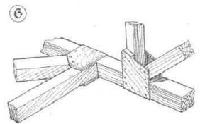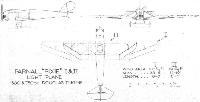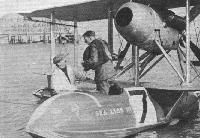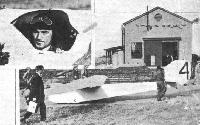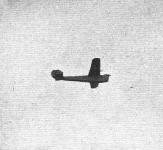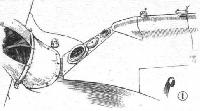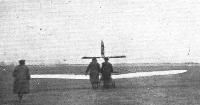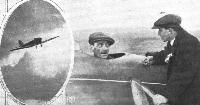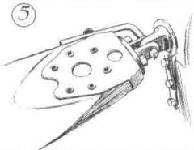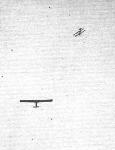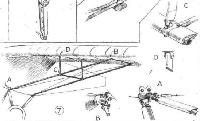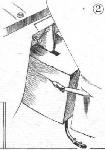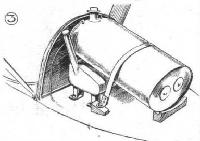Фотографии
-
The U.S. Navy-Curtiss R.2-C racer, winner of the 1923 Pulitzer Trophy Race, with a speed of 243-67 m.p.h. It is fitted with a 460 (500) h.p. Curtiss C.D.12 engine and wing radiators. Other characteristics are: Span, 22 ft. (top), 19 ft. 3 ins. (bottom); chord, 4 ft. 8 ins. (top), 3 ft. 4 ins. (bottom); gap, 3 ft. 2 ins.; stagger, 11 1/2 ins.; o.a. length, 19 ft. 8 1/2 ins.; height, 8 ft. 1 in.; wing area, 148-25 sq. ft.; weight empty, 1,690 lbs.; weight loaded, 2,071 lbs.; loading per h.p., 4-14 lbs.; loading per sq. ft., 14 lbs.; speed range, 74-247 m.p.h.; gliding angle, 1 in 9; ceiling, 32,000 ft.; Duralumin tractor screw, 7 ft. 10 ins. dia. by 10 ft. pitch.
Самолёты на фотографии: Curtiss R2C / R3C - США - 1923
-
WINNING THE SCHNEIDER TROPHY: This photograph shows the scene at the finish, with Lieut. David Rittenhouse. on the Navy-Curtiss racer, crossing the line after having covered the course at an average speed of 177.38 m.p.h. Mr. Withers' steam yacht, with a black cone hoisted, was one of the mark boats, and is seen on the right. On the left is a representative of the British Navy, a "P" boat, while in front is an American launch with the crew cheering the winner . The inset shows Rittenhouse starting in the race, and just by the nose of his machine may be seen the front portion and floats of the other American competitor, No.3, who got off a second or so before No.4.
Самолёты на фотографии: Curtiss CR / R-6 - США - 1921
-
The Schneider Cup Race Winners: On the right, Lieut. Rittenhouse being congratulated by his friend and compatriot Lieut. Irvine, who was second. The insets show the two Curtiss-Navy machines used. Irvine's cornering was, if anything, better than Rittenhouse's, but No. 3 was the slower machine.
Самолёты на фотографии: Curtiss CR / R-6 - США - 1921
-
THREE OF THE COMPETITORS ON SAUNDERS' SLIPWAY ON THE MORNING OF THE RACE: On the left, the Curtiss-Navy No. 3. In the centre, the Supermarine, and on the right, the C.A.M.S. 38
Самолёты на фотографии: CAMS CAMS 36 / CAMS 38 - Франция - 1922Curtiss CR / R-6 - США - 1921Supermarine Sea Lion / Sea King - Великобритания - 1919
-
THE SCHNEIDER CUP RACE: Capt. Biard, on the Supermarine "Sea Lion III," gets away, just as the American Navy-Curtiss No. 4 (Rittenhouse) rounds the mark boats after finishing his first lap. Inset shows Capt. Biard turning.
Самолёты на фотографии: Curtiss CR / R-6 - США - 1921Supermarine Sea Lion / Sea King - Великобритания - 1919
-
Lieut. Irvine (in shirt sleeves in middle of boat) going ashore after securing second place in Schneider Cup.
Самолёты на фотографии: Curtiss CR / R-6 - США - 1921
-
THE NAVIGABILITY TESTS: The two American representatives taxi-ing across the line.
Самолёты на фотографии: Curtiss CR / R-6 - США - 1921
-
Регистрационный номер: F-ESEJ [2] THE MOORING TEST: The six machines in line are, left to right, the Supermarine "SeaLion III," the two American Navy-Curtiss seaplanes, the C.A.M.S. flying boats, and the Latham twin-engined flying boat.
Самолёты на фотографии: CAMS CAMS 36 / CAMS 38 - Франция - 1922Curtiss CR / R-6 - США - 1921Latham L-1 / L-2 - Франция - 1923Supermarine Sea Lion / Sea King - Великобритания - 1919
-
Регистрационный номер: F-ESFD THE SCHNEIDER CUP RACE: Hurel, on the C.A.M.S.38 (No. 9), gets away well. In the inset is shown one of his turns around the mark boats. He only completed one lap of the course.
Самолёты на фотографии: CAMS CAMS 36 / CAMS 38 - Франция - 1922
-
THE PARNALL "PIXIE I": Three-quarter front view.
Самолёты на фотографии: Parnall Pixie - Великобритания - 1923
-
THE PARNALL "PIXIE I": View of the engine mounting, transmission and under carriage. The latter is of unusual type, consisting of two sloping struts carrying the axle. There is no springing beyond that provided by the flexibility of the steel tubes.
Самолёты на фотографии: Parnall Pixie - Великобритания - 1923
-
No. 9, the Parnall "Pixie I," at Lympne, being wheeled through a gate in the transport test. On the right, Capt. Macmillan, "Pixie's" pilot. Inset, the machine coming in to land.
Самолёты на фотографии: Parnall Pixie - Великобритания - 1923
-
THE PARNALL "PIXIE I": Three-quarter rear view. Standing by the machine are Capt. Macmillan, the pilot, and Mr. Bolas, chief engineer and designer of the Parnall machines.
Самолёты на фотографии: Parnall Pixie - Великобритания - 1923
-
76.1 m.p.h.: The Parnall "Pixie II," on which Capt. Macmillan won the Abdulla speed prize of ?500 at Lympne. A photograph of "Pixie I," which has larger wings and a smaller engine, was published last week.
Самолёты на фотографии: Parnall Pixie - Великобритания - 1923
-
LIGHT 'PLANES AT LYMPNE: Some interesting constructional features: 4, View into the cockpit of the Parnall "Pixie." Note the petrol level indicator.
Самолёты на фотографии: Parnall Pixie - Великобритания - 1923
-
LIGHT 'PLANES AT LYMPNE: Some constructional details. 1. Aileron on the Parnall "Pixie"; the rear spar is swept forward to meet the front spar at the wing tip; the ailerons have a differential action.
Самолёты на фотографии: Parnall Pixie - Великобритания - 1923
-
LIGHT 'PLANES AT LYMPNE: Some constructional details. 3. The neat strut-end with adjustment on the Parnall "Pixie."
Самолёты на фотографии: Parnall Pixie - Великобритания - 1923
-
LIGHT 'PLANES AT LYMPNE: A few interesting constructional features. In 6 is shown the joint of struts to longerons on the Parnall "Pixie."
Самолёты на фотографии: Parnall Pixie - Великобритания - 1923
-
LIGHT 'PLANES AT LYMPNE: Some constructional details. 7. Adjustable tail fitting on Parnall "Pixie."
Самолёты на фотографии: Parnall Pixie - Великобритания - 1923
-
Parnall "Pixie" I & II Light 'Plane 500 & 750 c.c. Douglas Engine
Самолёты на фотографии: Parnall Pixie - Великобритания - 1923
-
Регистрационный номер: G-EBAH Captain Biard, the pilot, on board the Supermarine "Sea Lion III."
Самолёты на фотографии: Supermarine Sea Lion / Sea King - Великобритания - 1919
-
THE BLACKBURN "PELLET" having a Lamblin radiator fitted and, on the right, Mr. Kenworthy photographed shortly before he started on the tests which ended in a crash.
Самолёты на фотографии: Blackburn Pellet - Великобритания - 1923
-
Longton wheeling out his "Wren" at Lympne. Inset, "listening" to his engine.
Самолёты на фотографии: English Electric Wren - Великобритания - 1923
-
THE AMAZING "WREN": Major Wright flying No. 3 at Lympne.
Самолёты на фотографии: English Electric Wren - Великобритания - 1923
-
THE NEW "WREN": Two views, taken at the Preston works of the English Electric Co., of the first of the competition "Wrens," which has now been finished and tested. This machine flies quite well on half throttle.
Самолёты на фотографии: English Electric Wren - Великобритания - 1923
-
The Competition "Wren": The A.B.C. engine is neatly cowled-in, and the instrument board is mounted just in front of the pilot, on the sloping back of the engine fairing, where it is easily visible.
Самолёты на фотографии: English Electric Wren - Великобритания - 1923
-
LIGHT 'PLANES AT LYMPNE: Some interesting constructional features: 1, the rear sloping edge of the engine mounting fairing on the "Wrens" is very ingeniously utilised as an instrument-board. The various dials are immediately in front of the pilot, and as they are out in the open they are well illuminated and consequently easily read.
Самолёты на фотографии: English Electric Wren - Великобритания - 1923
-
DE HAVILLAND MONOPLANES: The lower photograph shows Major Hemming wheeling out No. 12 for a flight at Lympne. This machine is known as the "Hemming-Bird," while the second de Havilland is called the "Humming-Bird." The upper pictures show No. 8 in flight, piloted by Capt. de Havilland, and No. 12, piloted by Major Hemming.
Самолёты на фотографии: De Havilland Humming Bird / D.H.53 - Великобритания - 1923
-
LIGHT 'PLANE COMPETITIONS: The official "shed." No. 8, one of the de Havilland machines, and No. 13, the Handasyde monoplane, in the shed ready for filling up.
Самолёты на фотографии: De Havilland Humming Bird / D.H.53 - Великобритания - 1923Handasyde monoplane - Великобритания - 1923
-
Perfectly Simple: Major Hemming and an assistant at Lympne wheeling out the de Havilland monoplane ''Sylvia II" by holding on to the propeller and letting the tail rise off the ground.
Самолёты на фотографии: De Havilland Humming Bird / D.H.53 - Великобритания - 1923
-
AIR-COMMODORE C. A. H. LONGCROFT TRIES THE DE HAVILLAND LIGHT 'PLANE: Our photograph shows the Commodore discussing the machine with Capt. Broad, while in the inset the machine is seen on a pretty banked turn. The machine was also flown by Wing-Commander Pretyman.
Самолёты на фотографии: De Havilland Humming Bird / D.H.53 - Великобритания - 1923
-
LIGHT 'PLANES AT LYMPNE: Some constructional details. 5. Wing strut attachment to fuselage on de Havilland monoplane.
Самолёты на фотографии: De Havilland Humming Bird / D.H.53 - Великобритания - 1923
-
THE FARMAN F.3X: This four-engined monoplane secured first place in the French "Grand Prix."
Самолёты на фотографии: Farman F.120 / F.3X / F.4X Jabiru - Франция - 1923
-
Регистрационный номер: G-EBHU [3] HEELING OUT THE GLOUCESTERSHIRE "GANNET": Engine trouble prevented the "Gannet" from taking part in the competitions. The inset shows the machine taking off for a flight.
Самолёты на фотографии: Gloster Gannet - Великобритания - 1923
-
Регистрационный номер: G-EBHU [3] THE GLOUCESTERSHIRE "GANNET": Three-quarter front views of the machine, with wings extended and folded.
Самолёты на фотографии: Gloster Gannet - Великобритания - 1923
-
Регистрационный номер: G-EBHU [3] LIGHT 'PLANES AT LYMPNE: Some interesting constructional features: 2, The cockpit of the Gloucestershire "Gannet."
Самолёты на фотографии: Gloster Gannet - Великобритания - 1923
-
LIGHT 'PLANES AT LYMPNE: A few constructional details. 1. The wing locking device on the Gloucestershire "Gannet"; the locking pin has a cam on it which engages with the slot in the steel plate; the trailing edge of the top centre-section folds up for folding the wings, and is held in position, when the wings are spread, by the fitting shown at A.
Самолёты на фотографии: Gloster Gannet - Великобритания - 1923
-
Gloucestershire "Gannet" Light 'Plane 750 c.c. Two Stroke Engine
Самолёты на фотографии: Gloster Gannet - Великобритания - 1923
-
The U.S. Night Air Mail Experiments. One of the mail 'planes (a converted D.H.) tuning up at Cheyenne aerodrome. In the background a Sperry 36-in. aerial beacon.
Самолёты на фотографии: Boeing DH-4M / O2B / Model 16 - США - 1920
-
Регистрационный номер: O-BAFG The "Poncelet" at Lympne Lieut. Simonet in the cockpit of his machine "Castar." Inset, the machine in flight.
Самолёты на фотографии: Poncelet Castar / Vivette - Бельгия - 1921
-
NO. 16, THE BELGIAN PONCELET LIGHT 'PLANE AT LYMPNE: Three-quarter front and rear views, and, below, the machine with wing stacked on top of the fuselage, ready for transport. The "Vivette," as No. 16 is called, is fitted with a four-cylinder Sergant engine.
Самолёты на фотографии: Poncelet Castar / Vivette - Бельгия - 1921
-
THE "VIVETTE" TURNS TURTLE: In starting for a flight at Lympne the Poncelet light 'plane "Vivette" was caught by a gust under one wing, with the result that she was blown on to one wing tip, buckled the port wheel, and turned over on her back. The pilot was unhurt. The larger photograph shows willing helpers carrying the machine back with her wheels uppermost, in the good old 1910-11 style. In the inset the machine is seen at the moment of striking.
Самолёты на фотографии: Poncelet Castar / Vivette - Бельгия - 1921
-
LIGHT 'PLANES AT LYMPNE: A few interesting constructional features. 2, The petrol tank on the Poncelet monoplanes forms a fairing behind the pilot's head.
Самолёты на фотографии: Poncelet Castar / Vivette - Бельгия - 1921
-
LIGHT 'PLANES AT LYMPNE: A few interesting constructional features. 3 shows the curious spur tail skid on the Poncelet;
Самолёты на фотографии: Poncelet Castar / Vivette - Бельгия - 1921
-
LIGHT 'PLANES AT LYMPNE: Some constructional details. 6. In the Poncelet monoplanes the gap between aileron and rear wing spar is covered with a strip of celluloid.
Самолёты на фотографии: Poncelet Castar / Vivette - Бельгия - 1921
-
Capt. Cockerell on the Vickers "Viget" (No. 10) flying above one of the A.N.E.C. monoplanes (No. 17) at Lympne.
Самолёты на фотографии: ANEC I / II - Великобритания - 1923Vickers Viget - Великобритания - 1923
-
Members of the A.N.E.C. contingent at Lympne: From left to right, Mr. and Mrs. Shackleton, Dr. Hope, Mr. James, and Mr. Piercey. "The Doctor" has taken a week's holiday, and is spending it at Lympne, where he has volunteered his services, should they be required.
Самолёты на фотографии: ANEC I / II - Великобритания - 1923
-
Plan view from below of the Gnosspelius "Gull" flying over Lympne aerodrome.
Самолёты на фотографии: Gnosspelius Gull - Великобритания - 1923
-
THE PEYRET MONOPLANE AT LYMPNE: The upper photograph shows the machine in side view, with M. Louis Peyret, the constructor, in the cockpit preparing to give the Sergant engine a test. Below the machine is seen during the transport test, while the inset shows it in flight.
Самолёты на фотографии: Peyret Avionette - Франция - 1923
-
LIGHT 'PLANES AT LYMPNE: A few interesting constructional features. The larger sketch in 7 shows the wing bracing of the Peyret monoplane with details. It seems probable that it was this bracing which failed and thus caused the wings to collapse.
Самолёты на фотографии: Peyret Avionette - Франция - 1923
-
Peyret Light 'Plane 16 hp Sergant Engine
Самолёты на фотографии: Peyret Avionette - Франция - 1923
-
The Vickers "Viget" at Lympne: Wheeling the machine out for a flight. Note the pilot's name painted on the side of the fuselage.
Самолёты на фотографии: Vickers Viget - Великобритания - 1923
-
Регистрационный номер: F-ESEJ [2] The Latham L.1 at her moorings.
Самолёты на фотографии: Latham L-1 / L-2 - Франция - 1923
-
Регистрационный номер: G-EBHW [3] The Avro light biplane: Side view.
Самолёты на фотографии: Avro Type 558 - Великобритания - 1923
-
A Row of Light 'Planes at Lympne: In the foreground the Avro biplane, No. 5. The spectators on the left are following the evolutions of Capt. Broad on a de Havilland monoplane.
Самолёты на фотографии: Avro Type 558 - Великобритания - 1923
-
Регистрационный номер: G-EBHW [3] The Avro light biplane: View of engine mounting, chain transmission, etc.
Самолёты на фотографии: Avro Type 558 - Великобритания - 1923
-
Регистрационный номер: G-EBHW [3] The Avro light biplane: Three-quarter front view.
Самолёты на фотографии: Avro Type 558 - Великобритания - 1923
-
LIGHT 'PLANES AT LYMPNE: A few constructional details. 2. The elevator crank lever, rudder crank, and tail skid of the Avro biplane.
Самолёты на фотографии: Avro Type 558 - Великобритания - 1923
-
LIGHT 'PLANES AT LYMPNE: Some constructional details. 2. Attachment of interplane strut on Avro biplane; note quick-release fittings.
Самолёты на фотографии: Avro Type 558 - Великобритания - 1923
-
LIGHT 'PLANES AT LYMPNE: Some interesting constructional features: 3, Petrol and oil tanks of the Avro biplane (No. 5).
Самолёты на фотографии: Avro Type 558 - Великобритания - 1923
-
Avro Light 'Plane Type 558 500 c.c. Douglas Engine
Самолёты на фотографии: Avro Type 558 - Великобритания - 1923
-
Регистрационный номер: J7322 [3] The Avro light monoplane: View of the fuselage in skeleton.
Самолёты на фотографии: Avro Type 560 - Великобритания - 1923
-
Регистрационный номер: J7322 [3] The Avro light monoplane: End view of a wing, showing bi-convex section used. The airspeed indicator is mounted inside the wing so that the pipes need not be broken when dismantling the machine.
Самолёты на фотографии: Avro Type 560 - Великобритания - 1923
-
Регистрационный номер: J7322 [3] The Avro light monoplane: View of engine mounting, tank, etc.
Самолёты на фотографии: Avro Type 560 - Великобритания - 1923
-
LIGHT 'PLANES AT LYMPNE: Some constructional details. 4. Aileron crank lever on Avro monoplane.
Самолёты на фотографии: Avro Type 560 - Великобритания - 1923
-
LIGHT 'PLANES AT LYMPNE: Some interesting constructional features: 5, The undercarriage of the Avro monoplane is of very clean design, the rubber shock absorbers being enclosed in the strut fairings.
Самолёты на фотографии: Avro Type 560 - Великобритания - 1923
-
Avro Light 'Plane Type 560 696 c.c. Blackburne Engine
Самолёты на фотографии: Avro Type 560 - Великобритания - 1923
-
Регистрационный номер: F-ESAQ THE FARMAN F.4S: A Goliath in its general lines, this machine has four Salmson engines, place in the "Grand Prix."
Самолёты на фотографии: Farman F.140 / F.4S Super Goliath - Франция - 1923
-
Регистрационный номер: G-EBHS [2] AFTER A FLIGHT: Bringing in the "Hurricane" monoplane. The lower picture gives a good idea of the lines of this machine, the general arrangement drawings of which were published last week. Inset, the machine in flight.
Самолёты на фотографии: RAE Hurricane - Великобритания - 1923
-
Регистрационный номер: G-EBHS [2] At Lympne: No. 14, the R.A.E. Aero Club's monoplane, the "Hurricane," being wheeled through a gate in the transport test.
Самолёты на фотографии: RAE Hurricane - Великобритания - 1923
-
LIGHT 'PLANES AT LYMPNE: A few interesting constructional features. 4, the unusual control stick arrangement on the "Hurricane."
Самолёты на фотографии: RAE Hurricane - Великобритания - 1923
-
LIGHT 'PLANES AT LYMPNE: A few interesting constructional features. 5, the laminated steel spring axle of the undercarriage.
Самолёты на фотографии: RAE Hurricane - Великобритания - 1923
-
R.A.E. Aero Club Light Monoplane 600 c.c. Douglas Engine
Самолёты на фотографии: RAE Hurricane - Великобритания - 1923
-
The Sayers-Handley Page monoplane, No. 23: This machine is generally similar to the S.C.W. glider built for Itford last year, but is fitted with a 500 c.c. Douglas engine.
Самолёты на фотографии: Handley Page H.P.22 / H.P.23 Sayers - Великобритания - 1923
-
THE SAYERS-HANDLEY PAGE MONOPLANE PASSES HER TRANSPORT TESTS AT LYMPNE: Inset, the machine in flight. Note the small opening in the roof through which the pilot is supposed to look. The addition of a periscope to the equipment of this machine seems to be called for.
Самолёты на фотографии: Handley Page H.P.22 / H.P.23 Sayers - Великобритания - 1923
-
The Sayers-Handley Page monoplane, No. 25: This photograph, taken at the Handley Page works some days ago, shows the machine without engine. An A.B.C. will be fitted. In the background may be seen the third monoplane, No. 26.
Самолёты на фотографии: Handley Page H.P.22 / H.P.23 Sayers - Великобритания - 1923
-
LIGHT 'PLANES AT LYMPNE: Some interesting constructional features: 6, The pilot's cockpit in the Sayers-Handley Page monoplane (No. 25) is totally enclosed, the pilot looking through two small openings in the roof. Late arrival at Lympne and a refractory engine prevented this machine from being thoroughly tested.
Самолёты на фотографии: Handley Page H.P.22 / H.P.23 Sayers - Великобритания - 1923
-
LIGHT 'PLANES AT LYMPNE: A few interesting constructional features. 1, The wing attachment on'the Sayers-Handley Page monoplane. The trap door is locked by the ingenious arrangement shown.
Самолёты на фотографии: Handley Page H.P.22 / H.P.23 Sayers - Великобритания - 1923
-
Sayers-Handley Page Light 'Plane 398 c.c. A.B.C. Engine
Самолёты на фотографии: Handley Page H.P.22 / H.P.23 Sayers - Великобритания - 1923
-
AN AMERICAN LIGHT 'PLANE: The "Mummert" cantilever monoplane, fitted with a standard Harley-Davidson motor-cycle engine.
Самолёты на фотографии: Mummert Mini-plane - США - 1923
Статьи
- Flight

